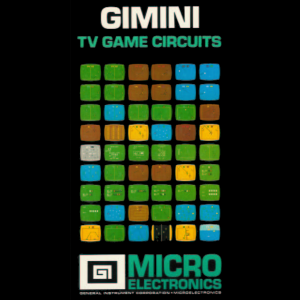In 1976, General Instruments released a series of integrated circuits that were designed for the consumer video game market: the AY-3-XXXX series. These chips were designed to output video to an RF modulator, which would then display the game on a domestic television set. Instead of creating their own console, General Instruments made these chips available to all. Suddenly, what used to be a very costly endeavor from and R&D perspective, became extremely trivial for toys/electronic that already dabbled with electronic components. The concept turns out to be incredibility popular and hundreds of companies jumped into the bandwagon of creating their own pong-like console, including Coleco, APF and Bandai, just to name a few.
Following this success, General Instruments decided to go a step further and create concepts for video game consoles that would use their own chips and parts. In the catalog of General Instruments in 1978, three types of GIMINI systems were listed as “PROGRAMMABLE TV GAMES”:
GIMINI 8600: The 8600 is the lower end of the GIMINI series which instead of using ROM-based cartridges would use cartridges that hold an AY-3-XXXX chip instead. The system was in fact solely used to provide power, controller input and video/sound output to the cartridge, while all the processing would be done within the cartridges itself. According to the GIMINI 8600 reference, there are only three chips mounted on the main unit: the RF modulator “astec um1082”, the color information generation chip “AY-3-8615”, and the sound stereo amplifier “LM386”. As it is a fairly simple circuit, the cost of manufacturing such a system would be very low. It could be manufactured even cheaper by removing the color and or the sound if desired. Takatoku Video Cassette Rock, Bandai TV Jack Add-on 5000 and PC-50X Series were all based on the GIMINI 8600 system. The 8600 remained popular for quite a while, especially in Europe where RAM-based consoles such as the Atari 2600 were not readily available.
GIMINI 8900: The 8900 is the high end of the GIMINI series is an ROM-Based system (referred to as Deluxe version in catalog) that is based on the “CP1610” CPU and “AY-3-8910” for sound. The system had much higher graphical capabilities than the GIMINI 8600, but was also much more complex, which means it was much more expensive to build. To our knowledge, the only system based on the GIMINI 8900 is the Mattel Intellivision.
GIMINI 8950: The 8950 is a tone down version of the GIMINI 8900. Called Challenger version, this was supposed to be a mid-range option between the 8600 and the 8900, but the system was still too expensive for manufacturers to be interested in it. The Champion 2711 by Unisonic is the only console based on the 8950.
As time passed, less and less video game console would use the GIMINI 8600 concept, opting instead for ROM-Based cartridges. The high cost of manufacturing an 8900 systems and the fierce completion among video game console in the early 80’s limited the opportunity for this concept to be adopted by other manufacturers.

